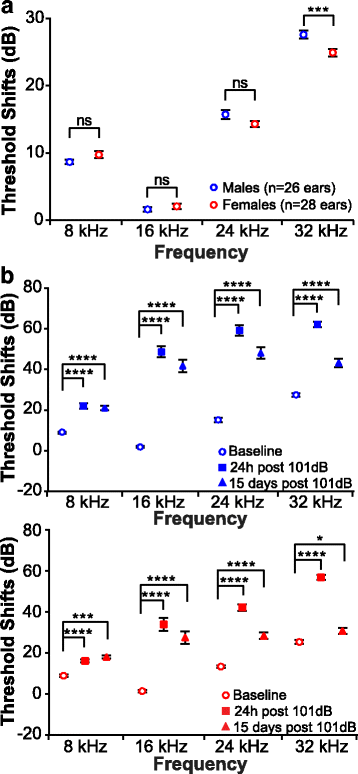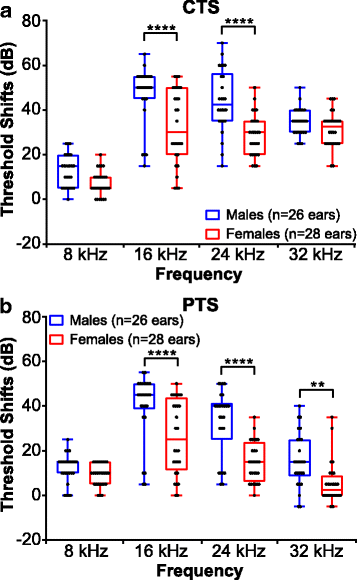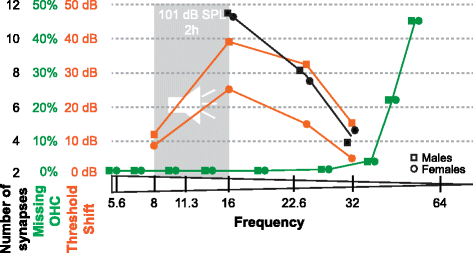The impact of biological sex on the response to noise and otoprotective therapies against acoustic injury in mice
- PMID: 29530094
- PMCID: PMC5848513
- DOI: 10.1186/s13293-018-0171-0
The impact of biological sex on the response to noise and otoprotective therapies against acoustic injury in mice
Abstract
Background: Noise-induced hearing loss (NIHL) is the most prevalent form of acquired hearing loss and affects about 40 million US adults. Among the suggested therapeutics tested in rodents, suberoylanilide hydroxamic acid (SAHA) has been shown to be otoprotective from NIHL; however, these results were limited to male mice.
Methods: Here we tested the effect of SAHA on the hearing of 10-week-old B6CBAF1/J mice of both sexes, which were exposed to 2 h of octave-band noise (101 dB SPL centered at 11.3 kHz). Hearing was assessed by measuring auditory brainstem responses (ABR) at 8, 16, 24, and 32 kHz, 1 week before, as well as at 24 h and 15-21 days following exposure (baseline, compound threshold shift (CTS) and permanent threshold shift (PTS), respectively), followed by histologic analyses.
Results: We found significant differences in the CTS and PTS of the control (vehicle injected) mice to noise, where females had a significantly smaller CTS at 16 and 24 kHz (p < 0.0001) and PTS at 16, 24, and 32 kHz (16 and 24 kHz p < 0.001, 32 kHz p < 0.01). This sexual dimorphic effect could not be explained by a differential loss of sensory cells or synapses but was reflected in the amplitude and amplitude progression of wave I of the ABR, which correlates with outer hair cell (OHC) function. Finally, the frequency of the protective effect of SAHA differed significantly between males (PTS, 24 kHz, p = 0.002) and females (PTS, 16 kHz, p = 0.003), and the magnitude of the protection was smaller in females than in males. Importantly, the magnitude of the protection by SAHA was smaller than the effect of sex as a biological factor in the vehicle-injected mice.
Conclusions: These results indicate that female mice are significantly protected from NIHL in comparison to males and that therapeutics for NIHL may have a different effect in males and females. The data highlight the importance of analyzing NIHL experiments from males and females, separately. Finally, these data also raise the possibility of effectors in the estrogen signaling pathway as novel therapeutics for NIHL.
Keywords: ABR; B6CBAF1/J mice; Inner ear; Noise-induced hearing loss; SAHA; Sex differences.
Conflict of interest statement
Ethics approval
All procedures involving animals were carried out in accordance with the National Institutes of Health Guide for the Care and Use of Laboratory Animals and have been approved by the Institutional Animal Care and Use Committee at the University of Maryland, Baltimore (protocol numbers 1015003 and 0915006).
Consent for publication
Not applicable.
Competing interests
The authors declare that they have no competing interests.
Publisher’s Note
Springer Nature remains neutral with regard to jurisdictional claims in published maps and institutional affiliations.
Figures







Similar articles
-
Metformin Protects Against Noise-Induced Hearing Loss in Male Mice.Otol Neurotol. 2023 Oct 1;44(9):956-963. doi: 10.1097/MAO.0000000000004002. Epub 2023 Aug 29. Otol Neurotol. 2023. PMID: 37641232 Free PMC article.
-
The effect of an age-related hearing loss gene (Ahl) on noise-induced hearing loss and cochlear damage from low-frequency noise.Hear Res. 2005 Jun;204(1-2):90-100. doi: 10.1016/j.heares.2005.01.004. Hear Res. 2005. PMID: 15925194
-
Candidate's thesis: enhancing intrinsic cochlear stress defenses to reduce noise-induced hearing loss.Laryngoscope. 2002 Sep;112(9):1515-32. doi: 10.1097/00005537-200209000-00001. Laryngoscope. 2002. PMID: 12352659
-
Genetic influences on susceptibility of the auditory system to aging and environmental factors.Scand Audiol Suppl. 1992;36:1-39. Scand Audiol Suppl. 1992. PMID: 1488615 Review.
-
Octave band noise exposure: Laboratory models and otoprotection efforts.J Acoust Soc Am. 2019 Nov;146(5):3800. doi: 10.1121/1.5133393. J Acoust Soc Am. 2019. PMID: 31795706 Free PMC article.
Cited by
-
Sexually dimorphic architecture and function of a mechanosensory circuit in C. elegans.Nat Commun. 2022 Nov 11;13(1):6825. doi: 10.1038/s41467-022-34661-3. Nat Commun. 2022. PMID: 36369281 Free PMC article.
-
Delay eyeblink conditioning performance and brain-wide c-Fos expression in male and female mice.Open Biol. 2023 May;13(5):220121. doi: 10.1098/rsob.220121. Epub 2023 May 10. Open Biol. 2023. PMID: 37161289 Free PMC article.
-
Sex Differences in the Triad of Acquired Sensorineural Hearing Loss.Int J Mol Sci. 2021 Jul 28;22(15):8111. doi: 10.3390/ijms22158111. Int J Mol Sci. 2021. PMID: 34360877 Free PMC article. Review.
-
Awareness of and the relationship between noise-induced hearing loss and the use of personal listening devices in Jazan region, Saudi Arabia.Front Public Health. 2025 Feb 21;13:1505442. doi: 10.3389/fpubh.2025.1505442. eCollection 2025. Front Public Health. 2025. PMID: 40061459 Free PMC article.
-
Single Cell and Single Nucleus RNA-Seq Reveal Cellular Heterogeneity and Homeostatic Regulatory Networks in Adult Mouse Stria Vascularis.Front Mol Neurosci. 2019 Dec 20;12:316. doi: 10.3389/fnmol.2019.00316. eCollection 2019. Front Mol Neurosci. 2019. PMID: 31920542 Free PMC article.
References
-
- U.S. Department of Veterans Affairs . Veterans benefit administration, annual benefits report, fiscal year 2016. 2016.
Publication types
MeSH terms
Substances
Grants and funding
LinkOut - more resources
Full Text Sources
Other Literature Sources
Medical
Research Materials
Miscellaneous

